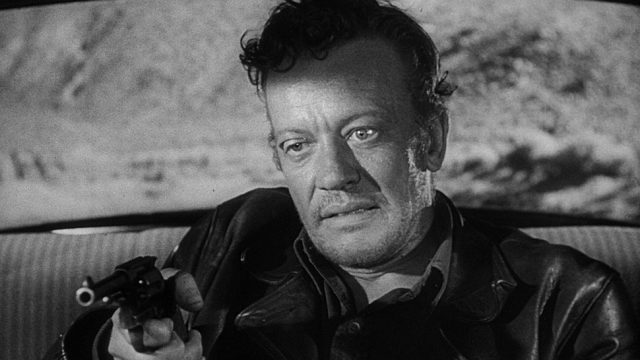If it’s difficult for female directors in Hollywood now, it was almost impossible in the 1950s.Only 13 films directed by women made it to theaters that entire decade, and three of them were released in 1953. Of these, perhaps the most important is Ida Lupino’s The Hitch-Hiker, arguably the first film noir directed by a woman. Even with Lupino’s acting stardom, her most famous movie as a director was a low-budget B-movie with no real “name” actors.
The Hitch-Hiker, as the prologue informs us, is based on a true story, in this case Billy Cook’s 1950 murder spree. In this telling, killer Emmett Myers (William Talman) takes Roy Collins and Gilbert Bowen (Edmond O’Brien and Frank Lovejoy, respectively), two blue-collar guys on a fishing trip in the Baja California peninsula, hostage after they stop to pick him up hitchhiking. Unfortunately, Lupino the writer (and cowriter/producer Collier Young) let Lupino the director down by occasionally letting the pacing go slack. It’d be harder to believe Myers would keep Collins and Bowen around if they were constantly trying to escape, but as it is a wealth of tension could be drawn from near-misses and the two men trying to outsmart their captor. There’s a little too much padding for a 70-minute movie.
It’s a little sad because Lupino shows a fantastic sense of framing and mise-en-scene and works well with her actors. Unlike other noirs, which are usually set in a city at night, much of The Hitch-Hiker takes place in the broad daylight of the desert. Whether due to budgetary or artistic concerns, this setting helps create an atmosphere of tension and dread. The two men feel isolated with a maniacal killer because there’s no one around for miles. Lupino’s best shots come in the first 10 minutes of the movie. During the prologue, we witness Myers murder the last people he hitchhiked with, but only from the level of Myers’s feet. After Collins and Bowen pick him up, Lupino keeps Myers in the dark until he pulls a gun. Suddenly, his face is illuminated as the camera pushes in while he leans forward. It’s a breathtaking moment.
Lupino’s directing career shows a smart filmmaker pressing up against the limitations of Hollywood sexism and skittishness. Her other films deal with taboo topics like bigamy, polio, out-of-wedlock pregnancy, and rape (indeed, Outrage is only the second post-Code movie to tackle the topic). It’s a little strange, then, that her most famous movie is a simple, nasty little true-crime thriller. But like the rest of her work as a director, The Hitch-Hiker shows a thoughtfulness and empathy rare in any filmmaking era (for instance, compare how she portrays the Mexican characters in this movie to any other Hollywood movie from the era). While she had to carve out a directing career of her own through sheer determination, she was vital to the development of the independent film industry as a space for directorial freedom.


